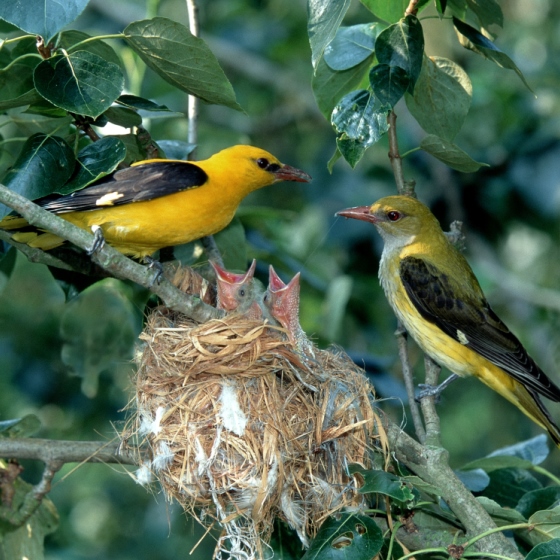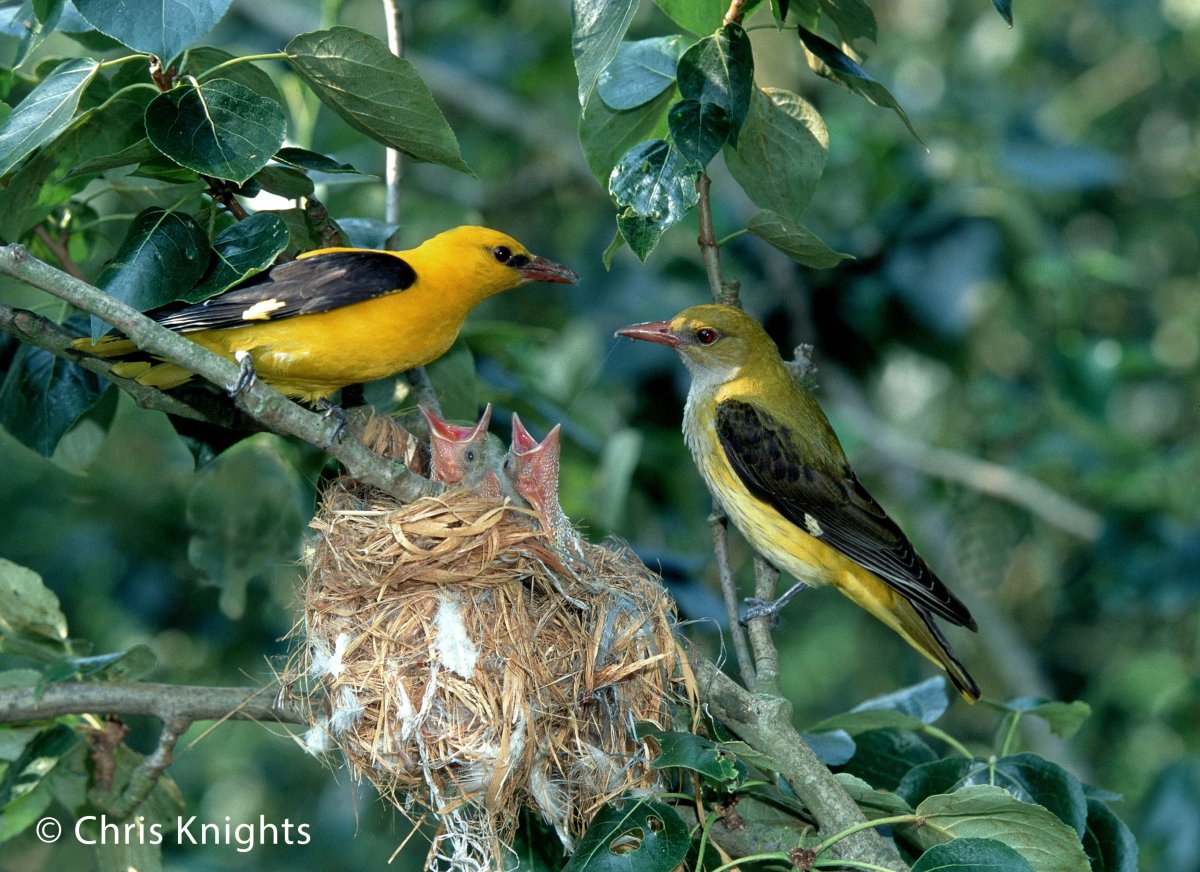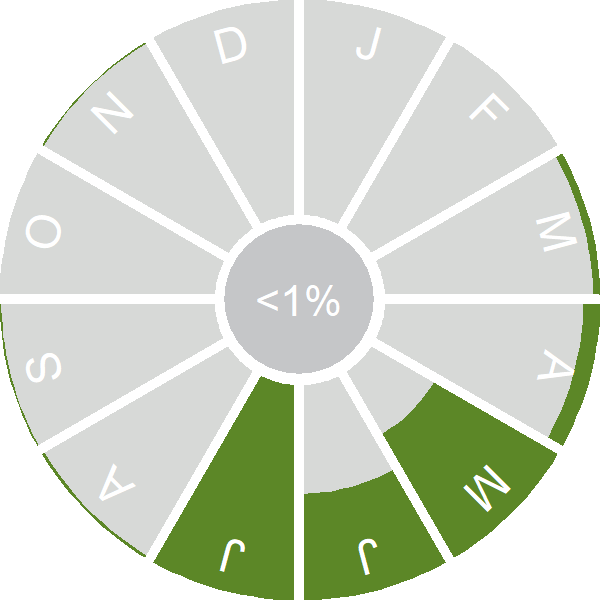Golden Oriole

Introduction
Formerly a rare but regular breeder, the Golden Oriole is now a scarce visitor, most commonly reported in the spring, from April to the middle of June.
The last regular breeding took place in East Anglia, and the bird's disappearance has been linked to declining populations elsewhere.

Key Stats
Identification
Songs and Calls
Song:
Status and Trends
Conservation Status
Population Size
Population Change
The Golden Oriole was a scarce but regular breeding species in poplar plantations in East Anglia during the 1980s and 1990s but breeding numbers at the former core population at Lakenheath collapsed from 27 pairs in 1987 to four pairs in 2005 (Mason & Allsop 2009). This decline continued subsequently and the species is now effectively extinct as a breeding species in the UK. Occasional singing males continue to be reported to the Rare Breeding Birds Panel in most years, but the last confirmed breeding was in 2009 (Eaton et al. 2021).
Distribution
Golden Orioles have declined significantly and no longer breed regularly. During 2008–11 breeding was confirmed in two 10-km squares in the Suffolk fens and possible breeding in 27 squares. Many records away from the Fens probably refer to migrants; non-breeding birds were reported in a further 93 10-km squares in Britain and five in Ireland.
or view it on Bird Atlas Mapstore.
European Distribution Map
Distribution Change
The change map highlights losses in the Fens and at other historical breeding sites.
Change in occupied 10-km squares in the UK
or view it on Bird Atlas Mapstore.
Seasonality
Golden Oriole is a former regular breeder and now mostly a spring overshoot migrant.
Weekly pattern of occurrence
The graph shows when the species is present in the UK, with taller bars indicating a higher likelihood of encountering the species in appropriate regions and habitats.

Movement
Britain & Ireland movement
Foreign locations of birds ringed or recovered in Britain & Ireland
Dots show the foreign destinations of birds ringed in Britain & Ireland, and the origins of birds ringed overseas that were subsequently recaptured, resighted or found dead in Britain & Ireland. Dot colours indicate the time of year that the species was present at the location.
- Winter (Nov-Feb)
- Spring (Mar-Apr)
- Summer (May-Jul)
- Autumn (Aug-Oct)

European movements
EuroBirdPortal uses birdwatcher's records, such as those logged in BirdTrack to map the flows of birds as they arrive and depart Europe. See maps for this species here.
The Eurasian-African Migration Atlas shows movements of individual birds ringed or recovered in Europe. See maps for this species here.
Biology
Productivity and Nesting
Nesting timing
Egg measurements
Clutch Size
Survival and Longevity
Survival is shown as the proportion of birds surviving from one year to the next and is derived from bird ringing data. It can also be used to estimate how long birds typically live.
View number ringed each year in the Online Ringing Report.
lifespan
Biometrics
Wing length and body weights are from live birds (source).
Ring Size
Classification, names and codes
Classification and Codes
- Order: Passeriformes
- Family: Oriolidae
- Scientific name: Oriolus oriolus
- Authority: Linnaeus, 1758
- BTO 2-letter code: OL
- BTO 5-letter code: GOLOR
- Euring code number: 15080
Alternate species names
- Catalan: oriol eurasiàtic
- Czech: žluva hajní
- Danish: Pirol
- Dutch: Wielewaal
- Estonian: peoleo
- Finnish: kuhankeittäjä
- French: Loriot d’Europe
- Gaelic: Buidheag-Eòrpach
- German: Pirol
- Hungarian: sárgarigó
- Icelandic: Laufglói
- Irish: Óiréal Órga
- Italian: Rigogolo
- Latvian: valodze
- Lithuanian: eurazine volunge
- Norwegian: Pirol
- Polish: wilga (zwyczajna)
- Portuguese: papa-figos
- Slovak: vlha obycajná
- Slovenian: kobilar
- Spanish: Oropéndola europea
- Swedish: sommargylling
- Welsh: Euryn
Research
Causes of Change and Solutions
Causes of change
The drivers of the UK declines are unclear but the British population is linked to population trends in the Low Countries which are declining and this may have made the isolated UK population more vulnerable by reducing immigration. The declines in the Netherlands have been linked to habitat degradation but this is considered unlikely to have driven the UK extinction as sufficient suitable habitat was still available (Mason & Allsop 2009).
Publications (2)
Spatial variation in spring arrival patterns of Afro-Palearctic bird migration across Europe
Author: Border, J.A., Boersch-Supan, P., Pearce-Higgins, J.W., Hewson, C., Howard, C., Stephens, P.A., Willis, S.G., Houston, A., Gargallo, G. & Baillie, S.R.
Published: 2024
The timing of migrant birds’ arrival on the breeding grounds, or spring arrival, can affect their survival and breeding success. The optimal time for spring arrival involves trade-offs between various factors, including the availability of food and suitable breeding habitat, and the risks of severe weather. Due to climate change, the timing of spring emergence has advanced for many plants and insects which affects the timing of maximum food availability for migratory birds in turn. The degree to which different bird species can adapt to this varies. Understanding the factors that influence spring arrival in different species can help us to predict how they may respond to future changes in climate.
02.05.24
Papers

The risk of extinction for birds in Great Britain
Author: Stanbury, A., Brown, A., Eaton, M., Aebischer, N., Gillings, S., Hearn, R., Noble, D., Stroud, D. & Gregory, R.
Published: 2017
The UK has lost seven species of breeding birds in the last 200 years. Conservation efforts to prevent this from happening to other species, both in the UK and around the world, are guided by species’ priorities lists, which are often informed by data on range, population size and the degree of decline or increase in numbers. These are the sorts of data that BTO collects through its core surveys.
01.09.17
Papers


